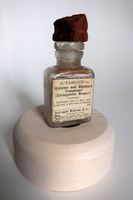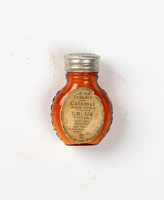Items
keywords is exactly
Calomel
-

Livingstone
A small wooden chip from the same object collection as the medicine chest balanced on top of one of the bottles from the chest. "The treatment, the Livingstone rouser, was formulated by Dr Livingstone, who, after an attack of malaria in 1853, patented this mixture of quinine and purgatives (calomel, rhubarb and jalop) mixed with opium (Barrett & Giordani 2017: 1655–1666). The chip balanced on its lid is said to be from the almond tree under which he proposed to Mary Moffat in 1844. The juxtaposition of these two objects, one representing the quantifiable and the other the poetic, draws the viewer to consider the conflation of these two realms" (Liebenberg 2021: 273). -
Quinine and Rhubarb Compound (Livingstone Rouser)
"Cathartic, tonic and anti-malarial. One to three may be taken with a little water, when an attack of malarial fever threatens, and repeated in two hours if necessary. Especially adapted for use as a purgative in the Tropics" (BWC 1925:136). The treatment, the Livingstone Rouser, was formulated by Dr Livingstone who, after an attack of malaria in 1853, patented this mixture of quinine and purgatives (calomel, rhubarb and jalop) mixed with opium. -

Calomel
"Alternative purgative. Use with caution. One to five of the smaller dose may be taken withh a draught of water as a cathartic and liver stimulant, or one, twice daily, as an alternative. The 5-grain dose is given in cases of jaundice accompanied by fever" (BWC 1925:122). -

No. 254. 'Tabloid' Brand Medicine Chest (The Indian)
A small medicine chest, listed as BC666, kept in the Manuscripts and Archives Department of the University of Cape Town. Roughly 15cm in height and depth, and 20cm in width, it is made of metal and painted black, with the words ‘Trade Mark’, 'Tabloid' and ‘Brand’ printed under the keyhole, on its front. Fitted with a brown leather strap and metal clasps, the case suggests easy portability and containment. Manufactured by Burroughs Wellcome & Co. in the 19th century, these travelling Tabloid brand medicine chests accompanied eminent explorers such as Stanley, Scott and Shackleton on their travels – and was a firm favourite amongst missionaries and explorers coming to Africa, seen as a tool to combat ‘tropicality’. This particular chest belonged to Walter Floyd, a dentist born in Kent, who opened a practice in Cape Town in 1904, and bought it for a hunting trip he made to (then) Northern Rhodesia in 1913.


